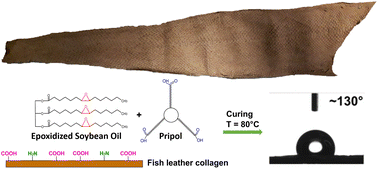Hydrophobic and water resistant fish leather: a fully sustainable combination of discarded biomass and by-products of the food industry†
Abstract
The food industry produces a large amount of food byproducts that, when appropriately valorized, can become a renewable source of sustainable materials. The valorization of these byproducts requires a new set of green technologies. For example, fish farming, one of the fastest growing sectors, uses only 30% to 40% of the fish as food, with the remaining 60% to 70% being a byproduct. One example of valorization of fish byproducts is the upcycling of fish skin into leather. This new fish leather has interesting properties, in part due to its microstructure, but also has new shortcomings like the high hydrophilicity and water absorption. To mitigate these issues, a water protecting coating was developed using only two other food byproducts: epoxidized soybean oil and the fatty acid trimer Pripol. These two building blocks were deposited on leather and then crosslinked to create a strong network that made leather hydrophobic, with a water contact angle >120° without the need for fluorine or silicone chemistry or the use of nanoparticles. The coating was applied via dip-coating and was cured at low temperature as required by fish leather without the need for initiators, catalysts, which are mostly toxic, or UV light. The same strategy could also be applied to cotton, showing that its application is not limited only to leather. The coating showed good adhesion to the substrate and excellent water resistance, making the leather and the cotton hydrophobic and substantially reducing the water absorption, without changing the breathability, flexibility and microstructure of the substrate. This work demonstrates how high performing materials can be created within a green chemistry and circular economy framework, with results that can be relevant for other textile materials, contributing to the effort for developing sustainable alternatives for providing hydrophobicity.

- This article is part of the themed collection: Celebrating International Women’s day 2025: Women in green chemistry


 Please wait while we load your content...
Please wait while we load your content...